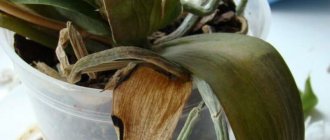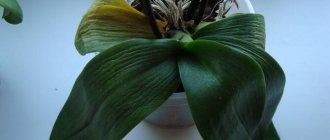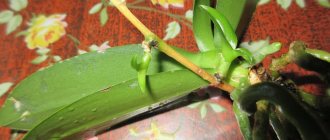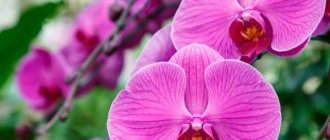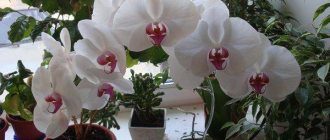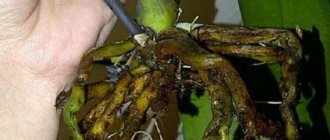Sometimes it can be observed that the substrate in the pot with the orchid has turned green. The reason for this is the bark that is part of the soil mixture.
It contains nutritional elements that serve as food for microorganisms, mosses and algae.
These satellites are not always useful to the orchid, so it is worth understanding why they appear and what to do in this case.
Below we will tell you about interesting facts about how green moss appears in an orchid pot.
The appearance of green moss in an orchid pot
The green coating that forms on the inside of the transparent pot is nothing more than algae. For their development it is necessary :
- Warm;
- Light;
- Humidity.
Green moss on the orchid appears in the warm season.
The combination of these factors can lead to :
- Mass proliferation of algae;
- Greening : Substrate;
- Roots;
- And the walls of the pot.
A similar situation occurs in small bodies of water in the summer and manifests itself in the form of algae blooms.
Causes
Why is the ground covered with moss in an orchid? Factors that lead to the growth of algae or moss in the soil are often caused by improper plant care :
- If the orchid is planted in a pot that is too large;
- Has a substrate that has compacted over time;
- Watering too often or too much.
Sometimes the plant looks healthy, in which case it is not touched. to take action if :
- The appearance of wilting leaves;
- Poor plant growth;
- A small number of roots.
If a green coating is found inside the pot, the orchid should be replanted .
Lighting
Under the influence of sunlight, photosynthesis occurs in the cells of green algae, so a green coating in pots is formed, as a rule, during the warm period - from the beginning of May to the end of summer. The side of the pot facing the room is covered with a green coating to a lesser extent. than the one facing the sun. Therefore, it is necessary to create the right lighting for the orchid.
Wet substrate
In addition to light, a prerequisite for the development of algae and moss in an orchid pot is high humidity..
Moss in a pot with an orchid forms at high humidity.
This usually happens in a pot with an orchid that grows :
- In a clear plastic pot and clear planter;
- In a transparent pot without drainage holes.
At the same time, the soil remains wet for a long time.
Mold and other bark problems
Symptoms of bark fungus and various diseases on phalaenopsis and other orchids?
Signs and treatment of indoor orchid substrate? Treatment methods: rot, fungal diseases, algae and other problems in a phalaenopsis pot, how to treat, treat and how to fight? How to cure a sick orchid and prevent mold? Often the gold standard for planting orchids in apartment conditions is the bark of coniferous trees; read more about the properties and preparation of the bark in our article. But whatever the beneficial properties of the bark, they cannot manifest themselves, and even become harmful under conditions of improper care. Therefore, the following problems may appear in the pot:
Why does mold appear in the substrate?
A shaggy white or gray “woolen” coating appears and grows on the surface of the substrate or on individual pieces of bark, as well as in the voids between pieces of bark. Such a coating can appear on the orchid itself, but only on its dead parts - dried scales, petioles of fallen leaves, dead roots. This is mold, a product of the vital activity of mold fungi. Microscopic spores of fungi are present everywhere in the environment, in the air, on the surface of objects. They can be in a “dormant” state for years and even decades. When favorable conditions occur, the spores germinate, the fungus develops and actively reproduces. The following conditions are favorable for mold:
As you can see, these are exactly the conditions that are not suitable for our beloved orchids and cause diseases. The most likely causes of mold are:
What is the mycelium in the orchid bark?
Thick webs and/or terry balls 0.1-1 mm in diameter (similar to eggs) of white, light yellow or light gray color inside and on the surface of the substrate are the mycelium of the fungus, mycelium, and has a characteristic smell of forest mycelium.
If the substrate is old or heavily damaged by mycelium, it is better to replace it completely, and also additionally treat the orchid roots with a fungicide in half the concentration. After transplantation, it is very important to optimize the conditions for keeping the orchid. Normal living conditions for an orchid. Watering after the substrate has completely dried does not allow the mycelium to develop, even if microscopic pieces of mycelium remain. Prevention is the same as in the case of mold in the substrate.
How to get rid of algae in an orchid pot?
Algae is a bright green coating on the walls of the pot, sometimes even on the roots of the orchid; green moss can be in the form of short, shaggy green threads. Algae grows in a humid environment and in bright light.
Algae and mosses harm the orchid by changing the properties of the substrate:
To get rid of algae in a pot with an orchid and with minor damage to the substrate, it is enough:
If algae and mosses have grown so much that they have filled the voids between the pieces of bark, the substrate must be replaced. The orchid roots should be washed with running water, the pot should be cleared of greenery and dried. It is important to prevent a new invasion of algae and mosses; the conditions for keeping the orchid must be optimized.
The best prevention of many fungal diseases and other problems is to follow normal orchid farming practices at any time of the year:
Source
What is the danger of the phenomenon?
Algae are not parasites, so they do not pose a danger to the orchid. But, in some cases, they cover the bottom with a dense layer and accumulate on the inner walls of the pot, making it difficult for air circulation in the soil and the breathing of roots.
Important! The appearance of moss or green algae indicates violations in the care and maintenance of the orchid.
Such a plant needs urgent adjustment of its care regimen .
Other Possible Problems
In addition to various infections, the orchid can suffer due to improper care, too cold wintering or excess sunlight.
Green spots and dark spots on flowers
The reason for the appearance of green and dark spots on orchid flowers is the ingress of a large amount of moisture during watering, as well as mechanical damage. Subsequently, such spots dry out and have uneven edges.
Sometimes spots and dark spots are formed as a result of the development of a fungal infection, such as gray rot. In such cases, flowers and buds are completely affected within 24 hours. To eliminate the problem, they resort to treatment with an antifungal drug.
Brown and other spots on leaves
Brown spots indicate a fungal infection. In this case, the plant is quarantined and treated with antifungal drugs. Prevention involves providing the plant with suitable conditions for growth and development, allowing it to maintain its immune system.
Read more about what diseases occur on orchid leaves, how to recognize and treat them here.
Sticky drops
The causes of sticky drops on orchid leaves are:
If harmful insects are detected, the plant is treated with an insecticide. In case of violation of the conditions of detention, treatment consists of following the rules of agricultural technology.
Burns
An epiphyte getting a burn is caused by:
In this case, the flower is immediately removed into the shade, and subsequently protected from direct sunlight.
Ways to fight
It is worth assessing the condition of the orchid - if the plant is healthy, actively growing roots and leaf mass, and the bark in the substrate is in good condition, it does not need replanting .
In this case, it is enough to reduce watering and remove the orchid from bright sun to a shaded place.
To combat green moss or algae:
- The pot with the plant is wrapped in any opaque material, for example, in foil;
- Place the flower pot in a dark, opaque pot.
This will reduce illumination and, accordingly, reduce the photosynthetic activity of algae. After some time, the green coating will disappear. If the orchid is in a pot, it is important to ensure that water does not stagnate in it.
Mold
On orchids
The familiar mold becomes a frequent enemy of orchid lovers. It can be seen on rotting fruits, damp walls, and, even worse, on your favorite plant. It consists of many types of fungi that can spread extremely quickly using microscopic spores.
Mold spreads very quickly.
Most common types
This fungal disease can affect all plant organs and even the substrate. So you can find mold on flowers, leaves, stems and bark.
Reasons for appearance
Mold appears on orchids just like on any other object. The fluffy coating spreads over everything that is accessible to it. Spores necessary for reproduction may be present in the substrate or in the air. The most optimal conditions for this are humidity and warmth.
Mold is easy to see with the naked eye. A clear sign that will help distinguish one species from another is color.
Most often, troubles with plants occur as a result of improper care . It is known that mold requires moisture and heat to spread. Such conditions are fundamental for the development of almost everything:
Mold itself does not harm the plant. She is a saprophyte, which means that she feeds on decaying organic matter, that is, she will not touch a healthy plant. In this case, she can warn that rotting and other diseases that will be much more difficult to treat are so close.
If mold appeared on the plant first, and not any of the above, then this can help prevent more serious orchid ailments.
Blue mold in the substrate
Through a transparent orchid pot you can see not only the state of the root system, but also the substrate. You can also find mold on it but not white, like on plant organs, but blue . Too much watering and high humidity provoke the spread of the disease.
In addition to errors in maintenance, mold can appear due to the fact that there were initially spores in the bark , which sprouted during normal watering.
Mold can be easily seen through the sides of a transparent pot.
Let's figure out how to get rid of mold in a pot of orchids. If there are very few blue islands, then you can try to let the substrate dry thoroughly ; you may not have to replant the plant. If there are a lot of them, then you cannot do without replacing the substrate:
Always boil the bark for a few minutes when planting orchids, whether homemade or store-bought. This reduces the risk of future appearance of fungal diseases and pests whose eggs could be in the substrate.
When is a transplant required?
If moss or algae multiply too much, the walls of the pot darken, and this can have a negative impact on the condition of the orchid, since mosses and algae clog the space between the roots and compact the substrate, depriving the roots of access to oxygen.
Such a plant needs to be transplanted into new soil after preliminary washing of the root system:
- The orchid is removed from the pot and freed from the substrate;
- The roots are washed several times in a solution of potassium permanganate (0.1%) or sodium chloride (1.0-1.5%);
- The plant is transplanted into a new, prepared substrate.
When replanting an orchid, wash the roots.
After transplantation, it is important to adjust the watering regime and the conditions for keeping the orchid.
Process technology
It is very important to choose the appropriate composition of the soil mixture, which takes into account the conditions in which the orchid will grow:
- For rooms with dry air, a third of the volume of the substrate should be occupied by a moisture-intensive component - sphagnum moss;
- In conditions of high or moderate humidity, add a minimal amount of sphagnum moss.
You can independently prepare a soil mixture suitable for specific conditions:
- Composition No. 1 , which includes charcoal and pine bark (1:5), is characterized by low moisture capacity and is optimal for growing orchids in a greenhouse;
- Composition No. 2 of charcoal, moss and pine bark cut into pieces (1:2:5) is suitable for planting orchids in baskets or pots;
- Composition No. 3 , containing pine bark with charcoal, moss and crushed polystyrene foam (5:1:1:1). This substrate has good moisture holding capacity and is best used in rooms with low humidity.
The bark is pre -boiled in water for an hour and then dried.
Advice! An incorrectly selected fertilizer composition may be a factor due to which the orchid does not form a peduncle. Thus, excessive application of nitrogen causes an increase in root mass and leaves, phosphorus stimulates the formation of a peduncle.
You need to feed the orchid only with special fertilizers with a low nitrogen content. The ratio of nitrogen, potassium and phosphorus 2:6:6 is optimal for stimulating orchid flowering.
What if the orchid is dormant?
If the orchid is in a dormant state, which, as a rule, occurs in the autumn-winter period, replanting the orchid is not recommended . At this time, all plant growth processes are very slow.
If the orchid is at rest, then it is better not to replant.
Also, you should not replant an orchid in the hot summer , when the orchid is stressed by high temperatures.
Important! An exception is made only if the plant's leaves or root system are damaged as a result.
If the plant is in the dormant phase:
- It is better to wait for the start of growth, when the plant produces a new leaf or new bulbs;
- Before transplanting, it is worth adjusting the frequency and abundance of watering, leaving 2-3 dry days between waterings.
This measure will not save you from green mosses and algae in the substrate, but will help stabilize the condition of the orchid before replanting.
Prevention
Experienced gardeners say that it is easier to prevent mold from occurring than to get rid of it later. Below are some of the most effective recommendations for combating fungus:
- Soil – it is important to constantly monitor the quality of the soil. To prevent the appearance of fungus, experts advise using a purchased substrate: firstly, it is tested for the presence of fungal microorganisms; secondly, in the store you can purchase soil for a specific type of plant. For additional protection of the soil, it can be covered with gravel or expanded clay.
- Pot - it is better to give preference to ceramic products. Their main advantage is their porous structure, which creates the necessary conditions for normal ventilation. Experienced gardeners recommend minimizing the use of plastic and metal pots.
- Drainage – only high-quality drainage can prevent the formation of stagnant water. Drainage material can be purchased at specialized hardware stores. Alternatively, you can use pieces of brick or gravel. It is important to regularly loosen the soil to prevent the formation of a hard crust and to improve the circulation of moisture in the soil.
- Watering - you need to know which watering regime is suitable for a particular plant, and strictly follow it. Some varieties of flowers do not tolerate excess moisture and may begin to rot.
- Disinfection – before using the substrate, it must be disinfected by treating it at high temperatures. There are several processing options: you can calcine the soil on a baking sheet in the oven or steam it over boiling water. Some gardeners additionally water the soil with a weak solution of potassium permanganate, and immediately before using the substrate, add activated carbon to it.
- Conditions – it is important to create optimal conditions for the plant. First of all, you need to take care of a sufficient amount of sunlight, because, as you know, the sun's rays also kill the fungus. Equally important conditions are normal humidity and the absence of drafts.
By following all the recommendations listed above, you will forever protect your plants from infection with fungal diseases.
Defeat
Leaves
The leaf blade is most often affected by white mold. If white mold is found on orchids - what to do?
In order to remove some of the spores and the fungi themselves, it is recommended to treat the leaves with a solution of copper sulfate.
Copper sulfate solution: dissolve 1 teaspoon of copper sulfate in two liters of settled water. Wipe the leaves with a cotton swab or spray, but not often, otherwise it will still be damp.
Particular attention should be paid to the axils of the leaves and avoid stagnation of water in them.
Roots
It is much more serious if the mold spreads to the root system. If this happens, then you need to immediately carefully remove the plant from the pot to assess the scale of the problem. The roots are washed under running water, the temperature of which is +35 degrees, and soaked in a fungicide solution , in a ratio of 1 to 6, for 15 minutes.
If rot or soft areas are found on the roots, it is necessary to remove these fragments using a sharp, disinfected blade, and treat the cut areas with crushed activated carbon or cinnamon.
Rotten roots must be cut off.
In order to prevent mold from appearing again, it is better to change the substrate , as there may be spores in it, and also wash the pot. Old bark should be boiled for a few minutes so that it can be safely used in the future.
Peduncles and buds
If the plant is already affected by white mold and has flowered, and the old buds and flower stalks have not been removed, then the fungal disease can begin to spread from them. In this case , you just need to promptly remove dead parts of the plant so as not to provoke the appearance of mold.
Whole plant
You can see mold on a healthy peduncle only if the entire plant has already been captured. Since it has already spread throughout the entire orchid, there is a very high risk that some part is rotting. First you need to pull out the orchid to inspect it, remove excess, then rinse with fungicide. The substrate must be replaced with a new one.
In case of severe rot it is better to remove the flower stalks , since the orchid is now in a painful and weakened state, and flowering requires a lot of effort. After the plant is returned to the washed pot, you should again think about the correct maintenance and understand the reasons for such a rapid spread of the fungus.
